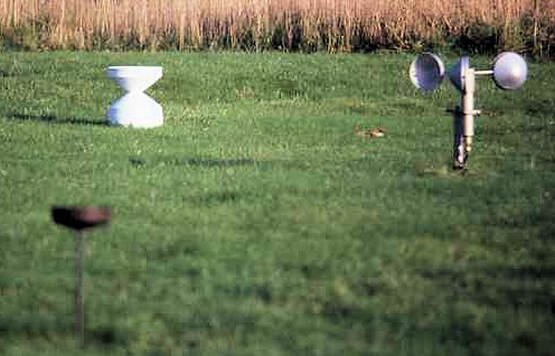The ARG Rain Gauge
By Dr. Ian Strangeways
The ARG (Aerodynamic Rain Gauge) evolved from earlier designs. The original idea was for a low-cost instrument system for developing countries, that could ill-afford the costly instruments currently available at the time. It was while the author was working in Brazil, on temporary-secondment to UNESCO, concerning a project in the Upper Paraguay River Basin, that this idea first came to mind. Cost can be a very important factor in setting-up a network of hydrological instruments anywhere in the world, but it is particularly significant in countries that have limited financial resources. Indeed, this constraint is not limited to developing countries, it is a factor everywhere, and cost is often the deciding factor in selecting an instrument, provided it also meets technical requirements.
|
Figure 2 (above left): First design of the aerodynamic, ARG series of rain gauges, using vacuum-forming construction.
Figure 3 (above right): Second design of the ARG series of rain gauges, introducing a more substantial construction. This model was licenced for production. |
While changing to vacuum-forming manufacture, advantage was taken of this technique’s more flexible properties to produce an aerodynamic profile, rather than the conventional cylindrical shape. Aerodynamic-profiles had been shown to reduce the effects of wind-loss on the catch of the gauge (Rodda 1967, Strangeways 2003). Indeed, errors due to wind-loss in rainfall measurement are often either ignored, or just not appreciated, by those selecting and installing rain gauges. Such errors can be very large in exposed areas, and many rainfall datasets are probably five to ten percent low due to this effect. It is worth noting that the measurement of snowfall is affected to a much greater extent, than is rainfall, by wind effects; but this is another complex matter. The first vacuum-formed design (Figure 2) had a narrow neck between the top section (the funnel) and the lower section (the tipping-bucket and logger housing) and this proved to be a vulnerable, weak point. The next design (Figure 3) made the construction much more robust, although basically identical in concept. |
This design was tested in the field on the IH met site at Wallingford (Figure 4). A comprehensive test was also carried out in the mountainous area of Plynlimon (Figure 5) where IH was operating a double-catchment project of long-duration, which is currently still in operation under the management of the Centre for Ecology and Hydrology (CEH). This test compared many different gauges and different exposures, over an extended period.
Figure 6 illustrates the tools used to vacuum-form the gauges. The ARG has proved remarkably successful and popular, selling in vast numbers for over 30 years. It can be seen in numerous photographs of met-sites around the globe. Although the original idea was a low-cost instrument for developing countries, the ARG proved popular at all levels of sophistication. Despite its low cost, it has proved to be reliable and accurate and matched the performance of gauges of much greater expense.
References
Rodda, J. C. (1967) The systematic error in rainfall measurement, J. Inst. Water Eng., 21, 173-9.
Strangeways, I. C. (2003). Measuring the Natural Environment (Second edition) Cambridge University Press ISBN 0 521 82205 X hardback. 0 521 52952 2 paperback.
Strangeways, I. C. (2004). Improving precipitation measurement. International Journal of Climatology, 24, 1443-1460.
Rodda, J. C. (1967) The systematic error in rainfall measurement, J. Inst. Water Eng., 21, 173-9.
Strangeways, I. C. (2003). Measuring the Natural Environment (Second edition) Cambridge University Press ISBN 0 521 82205 X hardback. 0 521 52952 2 paperback.
Strangeways, I. C. (2004). Improving precipitation measurement. International Journal of Climatology, 24, 1443-1460.






